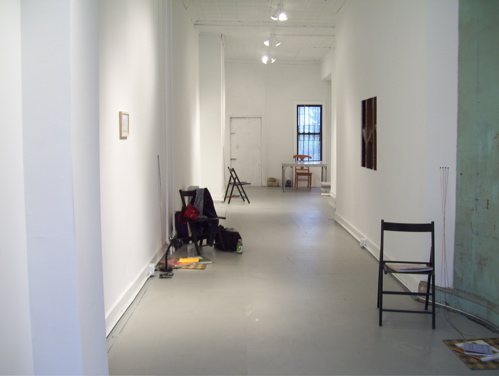This is an archive of the ArtCat Zine, 2007-2009. Please visit our new project, IDIOM.
A Lawrence Weiner Salon at Pocket Utopia

Courtesy of the Pocket Utopia Blog.
A Lawrence Weiner Salon
2 November - 25 November, 2007
Pocket Utopia - 1037 Flushing Avenue, Brooklyn NY
In his 'Notes on & About Art,' from 1995, Lawrence Weiner insists
ART IS NOT A METAPHOR UPON THE RELATIONSHIPS OF HUMAN BEINGS TO OBJECTS & OBJECTS TO OBJECTS IN RELATION TO HUMAN BEINGS BUT A REPRESENTATION OF AN EMPIRCAL EXISTING FACT …IF AND WHEN A PRESENTATIONAL SITUATION CANNOT ACCOMMODATE BY VIRTUE OF SELF-PROTECTION (CONFLICT OF BASIC IDEOLOGIES) A WORK OF ART IT (THE WORK OF ART) THEN MUST ERECT A STRUCTURE CAPABLE OF SUPPORTING ITSELF (THE WORK OF ART)
BUT WHATSOEVER SUPPORT IS FOUND CAPABLE BECOMES IN EFFECT LEGITIMIZED PERHAPS THE DIALECTIC CONCLUDES AS THE SYSTEM OF SUPPORT CHANGES
I would like to nominate the Lawrence Weiner Salon currently open at Pocket Utopia as the arrival of just such a self-supporting structure, with all attendant implications, but first, the details.
Pocket Utopia is a self-described 'away-from center, off-center, exhibition salon and social space run by artist Austin Thomas.' In setting up the Weiner salon, Thomas has carefully attended to the implications of the interaction between purpose and Weiner's work, to delightful effect. Thus the three main components of the show; 'a reading room, a re-creation, and a text piece,' can be seen as reflecting the social space, the salon, and the exhibition, respectively. All three are worth the trip, in and of themselves. The text piece, 'ART IS NOT A GAME IT HAS NO RULES' remains superlative at capturing Wiener's unique combination of playful beauty and intense seriousness, while the reading room has been dutifully stocked with much of Weiner's textual output, including his own book works, interviews, and collaborations with other artists. One could do far worse on a lazy Sunday than to spend it flipping through these volumes, chatting with the intelligent, amicable Thomas, and enjoying a coffee from the local bodega. It was certainly the highlight of my week.
What concerns me here, however, is the middle pairing, indicated above, of the 're-creation,' and the salon, as it crystallizes my earlier assertion regarding the arrival of that specific sort of presentational space discussed by Weiner in his 'Notes…' The term 'salon,' of course, has all kinds of historical resonance in the index of presentational spaces, and without forcing the issue, it is easy to read Thomas's choice of the word as inserting her own social space into precisely this history. Thus, it is not that Pocket Utopia is a salon of the same type made famous in 19th century Paris, say, but rather it is a presentational space rooted in its moment and location in a way that is consistent with the historical progression of such spaces of which the Paris salon is but one, albeit archetypal, example. Thus we have the invocation of this Narrative not on the level of form but of fidelity, which in turn subtracts any specification of form or content that would do a preordained violence to the vagaries of the present moment, impoverished or otherwise. Were Pocket Utopia located in a certain mainland neighborhood with a silly name this would manifestly not be the case. Indeed it is precisely its distance from center that provides the architectural support for this evacuation, the divine freedom of the marginal. (Close readers will no doubt note the imperialist moment in all of this, as the Morgan Avenue stop is certainly not without its own history, cultural, artistic or otherwise, it is hardly some sort of tabula rasa beckoning to the intrepid. Yet it remains the case that this peculiar vocabulary and its attendant antecedents have always been but fleas on the overgrown rat of progress. Perhaps the best we can hope is to incubate the right disease.)
In this as-yet indefinite space, this 'salon,' we have the aforementioned 're-creation,' "A 36" x 36" Removal to the Lathing or Support Wall of Plaster or Wallboard From a Wall," first performed in 1968. Thomas' use of the term 're-creation,' should immediately strike anyone familiar with Weiner's 'Declaration of Intent,' as a highly suggestive choice. The declaration, which probably remains Weiner's most famous work, reads in part:
1. THE ARTIST MAY CONSTRUCT THE WORK 2. THE WORK MAY BE FABRICATED 3. THE WORK NEED NOT BE BUILT EACH BEING EQUAL AND CONSISTENT WITH THE INTENT OF THE ARTIST
Thus the 're-creation,' isn't, as such, or shouldn't be, but is rather the work itself, merely another instance of its appearing, and as equal and consistent with the intent of the artist as when it was first enacted. In the same way that a given production of Hamlet is not a re-creation of Hamlet, but the thing itself, for better and for worse, so the hole in the wall of Pocket Utopia is as much of an original as ever there was.
Unless, of course, something has changed, and, if my earlier assertions about the arrival of a novel sort of presentational space are accurate, it is not too much to say that is precisely what has taken place. To wit, Weiner writes, "PERHAPS THE DIALECTIC CONCLUDES AS THE SYSTEM OF SUPPORT CHANGES" Isn't it precisely the conclusion of this dialectic, its coming to rest, that we see at work in use of 're-creation?' As Weiner's work passes into the canon, as it calcifies and hardens into history, I can think of no better homage, no better monument to his brilliance and brio, than a subway ride to a pocket utopia where his 'Removal…' is now, at last, merely a 're-creation.'
ZINE
HOME
TIPS / COMMENTS
CATEGORIES
CONTRIBUTORS
- Greg Afinogenov
- B. Blagojevic
- Adda Birnir
- Susannah Edelbaum
- Julie Fishkin
- Paddy Johnson
- Jessica Loudis
- Christopher Reiger
- Andrew Robinson
- Peter J. Russo
- Blythe Sheldon
- S.C.Squibb
- Hrag Vartanian
